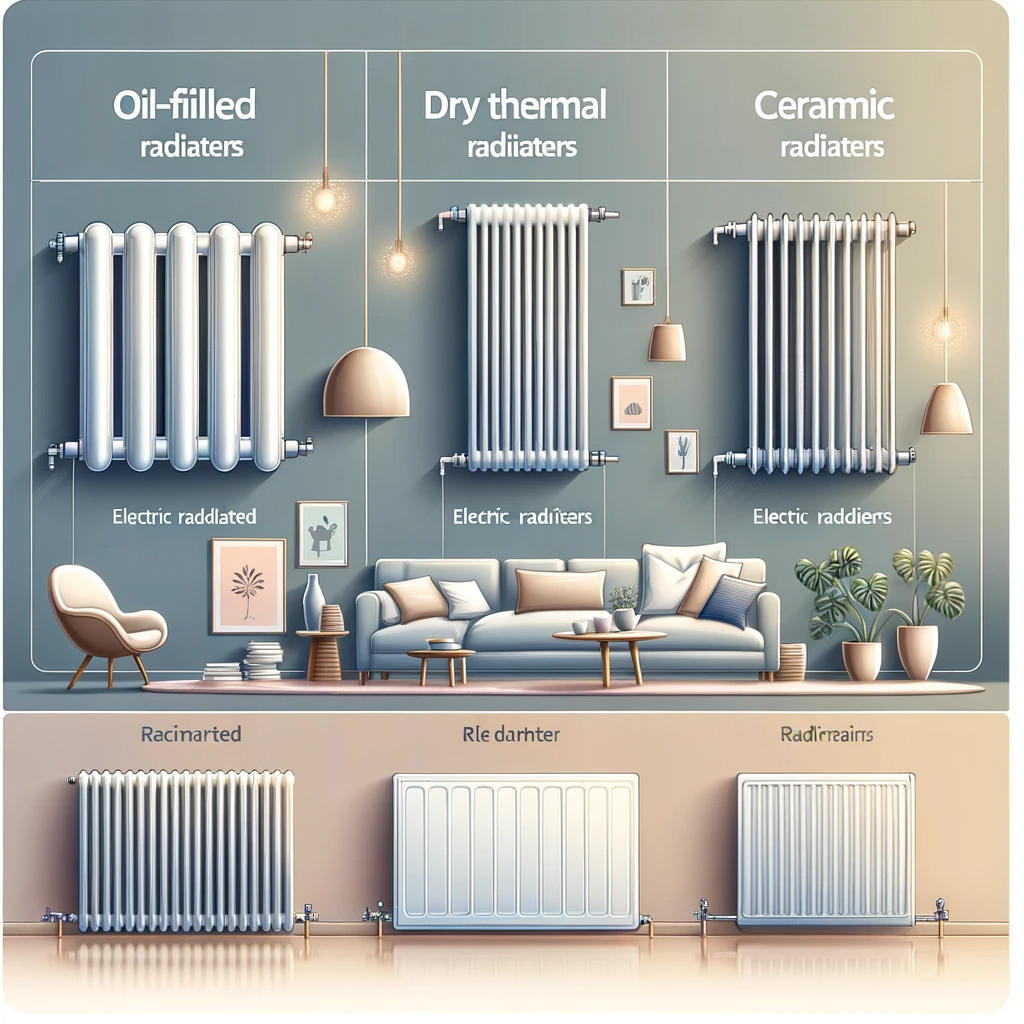Are Electric Radiators Safe? An In-Depth Exploration
As the chill of winter sets in, many of us turn to various heating solutions to keep our homes warm and comfortable. Among these, electric radiators have emerged as a popular choice, known for their efficiency and convenience.
However, with this choice comes an important question that many homeowners and renters alike find themselves pondering: Are electric radiators safe?
In this blog, we delve into the heart of this query, aiming to provide a comprehensive understanding of electric radiators and their safety aspects.
From exploring their design and functionality to examining their safety features and certifications, we’ll cover all the bases to help you make an informed decision about using electric radiators in your home.
Join us as we unravel the myths, understand the facts, and offer you peace of mind about this modern heating solution.
Key takeaways for are electric heaters safe
- Popularity of Electric Radiators: Electric radiators are increasingly popular due to their efficiency and convenience, especially in colder months.
- Safety Concerns: Homeowners and renters often question the safety of electric radiators, which is a critical consideration.
- Purpose of the Blog: The blog aims to thoroughly understand electric radiators, focusing on their safety aspects.
- Comprehensive Coverage: The blog will explore the design, functionality, safety features, and certifications of electric radiators.
- Myth-Busting: It will address common myths and misconceptions about electric radiators.
- Informed Decision Making: The goal is to equip readers with factual information for making well-informed decisions about using electric radiators in their homes.
- Reassurance and Clarity: The blog seeks to offer clarity and peace of mind regarding using electric radiators as a heating solution.
Understanding Electric Radiators
What Are Electric Radiators?
Electric radiators are modern heating solutions commonly used in homes and offices.
Unlike traditional water-based radiators, they don’t rely on a central heating system.
Instead, they use electricity to generate heat, offering more flexibility in temperature control and installation.
Read on to learn about this from Which
Working Mechanism
Electric radiators operate by converting electrical energy into heat.
This process is known as electric resistance heating, where electricity flows through a heating element.
The element heats up and radiates warmth into the room, providing efficient and consistent heating.
Types of Electric Radiators
There are several types of electric radiators, each with unique features and benefits:
- Oil-Filled Radiators: These contain thermally conductive oil.
The oil is heated by electric elements, and the heat is then radiated into the room.
They are known for their ability to retain heat, making them energy-efficient. - Dry Thermal Radiators: These have no liquid and use a dry thermal element to produce heat.
They are lightweight, heat up quickly, and offer precise temperature control. - Ceramic Radiators: These feature ceramic heating elements.
They are excellent at retaining heat and provide a steady, even distribution of warmth.
Ceramic radiators are often chosen for their long-lasting and efficient heating capabilities.

Safety Features of Electric Radiators
Built-in Safety Mechanisms
Electric radiators are equipped with advanced safety features to ensure user protection:
- Thermal Limiters: These crucial components prevent overheating by automatically shutting off the radiator if it reaches an unsafe temperature.
- Automatic Shut-Off Features: This feature is particularly useful in preventing accidents. For example, if the radiator tips over, it will automatically turn off.
- Overheat Protection: Additional sensors to detect and prevent potential overheating scenarios.
- Child Locks: This safety feature prevents accidental adjustments or tampering by children, ensuring the settings remain as intended.
Certifications and Standards
Electric radiators must adhere to stringent safety certifications and standards:
- CSA (Canadian Standards Association): Certification ensures compliance with North American safety standards, indicating rigorous testing and safety assurance.
- CE Marking: A mark of conformity with European health, safety, and environmental protection standards. It’s a guarantee of product safety within the European Economic Area.
- BS EN 60335: A British Standard specific to the safety of household electrical appliances, underlining the safety measures specific to electric radiators.
Comparison with Gas Radiators
Comparing electric and gas radiators reveals significant safety differences:
- No Combustion Risks: Electric radiators don’t burn fuel, thus eliminating risks associated with gas combustion, such as carbon monoxide emission.
- Lower Fire Hazard: Electric radiators have a lower fire hazard compared to gas radiators as they don’t involve open flames or leaky gas connections.
- Indoor Air Quality: Unlike gas radiators, electric models do not impact indoor air quality as they do not emit fumes or consume oxygen.
Installation and Usage
Proper Installation Guidelines
Electric radiators are relatively straightforward to install, but proper installation is key to ensuring safety and optimal performance.
Step 1: Choose the right location, keeping the radiator away from flammable materials.
Step 2: Ensure the wall is sturdy enough to support the radiator if wall-mounted.
Step 3: Securely mount the radiator using the provided brackets and hardware.
Step 4: Plug the radiator into a nearby power outlet; avoid using extension cords.
Step 5: Set up the thermostat and control settings according to your needs.
Optimal Placement and Positioning
The right placement of your electric radiator is crucial for safety and efficiency.
Avoid Obstructions: Keep the radiator clear of furniture and curtains to allow free air circulation.
Level Surface: If freestanding, place it on a level surface to avoid tipping.
Bathroom Use: For bathroom installation, ensure the radiator’s IP rating is suitable for wet areas.
User and Pet Safety Considerations
When it comes to children and pets, extra precautions are necessary.
Safe Distance: Teach children to maintain a safe distance from the radiator to avoid burns.
Pet Safety: Position the radiator in a way that pets cannot climb on or touch the hot surfaces.
Lockable Controls: Use models with lockable controls to prevent accidental adjustments by children or pets.
Smart Features and Energy Efficiency
Smart Control and Accessibility
Electric radiators have embraced modern technology, offering smart features for enhanced control and accessibility.
Mobile Device Integration: Many models can be controlled via a smartphone app, allowing you to adjust settings remotely.
Voice Assistant Compatibility: Some electric radiators are compatible with voice assistants like Amazon Alexa or Google Assistant, providing hands-free control.
Programmable Thermostats: These allow for scheduling heating times, ensuring efficient use and convenience.
Energy Efficiency
One of the most significant advantages of electric radiators is their energy efficiency.
Precise Temperature Control: They provide more accurate temperature control than traditional radiators, reducing energy waste.
No Heat Loss: Electric radiators convert almost 100% of the electrical energy into heat, ensuring minimal loss.
Impact on Safety: Enhanced energy efficiency also contributes to safety, as it reduces the risk of overheating and energy-related accidents.

Maintenance and Long-term Safety
Maintenance Tips
Regular maintenance is key to the longevity and safety of electric radiators.
Dust Regularly: Accumulated dust can impair efficiency; gently clean the radiator’s surface and fins.
Check Electrical Connections: Regularly inspect for any loose connections or wear.
Thermostat Calibration: Ensure the thermostat is calibrated correctly for accurate temperature control.
Avoid Obstructions: Keep the radiator clear of obstructions that could hinder heat distribution and cause overheating.
Durability and Longevity
Electric radiators are known for their robust construction and long-term performance.
Lifespan: With proper maintenance, they can last for many years, often outliving traditional radiators.
Constant Performance: They maintain consistent heating performance over time, unlike systems that can degrade.
Low Wear and Tear: Electric radiators have fewer moving parts, leading to less wear and tear than other heating systems.
Investment Value: The initial investment in an electric radiator pays off in the long term due to its durability and energy efficiency.
Debunking Myths and Misconceptions of are electric radiators safe
Common Myths
Electric radiators, like any popular technology, are surrounded by myths and misconceptions. Let’s address and debunk some of the most common ones:
- Myth: They are extremely expensive to run
Fact: Modern electric radiators are energy-efficient and can be cost-effective, especially with smart controls. - Myth: They are not safe for households with children or pets
Fact: With safety features like automatic shut-off and thermal limiters, they are safe for all household environments. - Myth: Electric radiators can’t heat large spaces effectively
Fact: With the right size and placement, electric radiators are capable of heating large areas uniformly.
Factual Reassurances
To counter these myths, it’s essential to rely on evidence-based information:
- Energy Efficiency: Studies and tests show that modern electric radiators are designed for maximum energy efficiency.
- Safety Certifications: Reputable manufacturers adhere to strict safety standards, as evidenced by certifications like CSA and CE.
- Customer Testimonials: Real-life user experiences often highlight the efficiency and safety of electric radiators, debunking common misconceptions.
Real-world Applications and Testimonials
Case Studies
Real-life examples showcase the effectiveness and versatility of electric radiators:
Home Heating Solution: A family in a Victorian house replaced old gas heaters with electric radiators, significantly improving warmth and reducing bills.
Office Environment: A tech startup office installed electric radiators for their energy efficiency and easy temperature control, enhancing employee comfort.
Public Spaces: A local library opted for electric radiators for their silent operation and safe heating, creating a cosy environment for visitors.
User Testimonials
Positive reviews and testimonials highlight customer satisfaction and safety:
- “Switching to electric radiators has been a game-changer for our home’s comfort and safety.” – Emma, homeowner
- “Our office has never been more comfortable. The temperature control with electric radiators is precise and reliable.” – Jake, office manager
- “As a parent, I feel much safer with electric radiators. The safety features give me peace of mind.” – Sarah, mother of two
FAQ: Are Electric Radiators Safe
1. Are electric radiators safe to leave on overnight?
Yes, most electric radiators are safe to leave on overnight, especially those with built-in safety features like thermal limiters and automatic shut-off. However, it’s important to follow manufacturer guidelines and ensure they are properly installed and maintained.
2. What are the disadvantages of electric radiators?
The main disadvantages include potentially higher electricity costs compared to gas heating, the need for a nearby electrical outlet, and the upfront cost, which can be higher than other types of heaters.
3. Do electric radiators give off fumes?
No, electric radiators do not give off fumes. Unlike gas heaters, they operate using electricity and do not burn fuel, thus eliminating the risk of fume emission.
4. Are electric heaters safe to use indoors?
Yes, electric heaters are safe to use indoors if they are used according to the manufacturer’s instructions. It’s important to keep them away from flammable materials and ensure they have safety features like overheat protection.
5. Is it cheaper to leave electric radiators on all the time?
Not necessarily. While maintaining a constant temperature can be efficient, it may lead to higher energy consumption. Using programmable thermostats to control when the radiator turns on and off can be more cost-effective.
6. What is the lifespan of an electric radiator?
The lifespan of an electric radiator typically ranges from 15 to 20 years, depending on the quality of the radiator and how well it is maintained.
7. Do electric radiators have carbon monoxide?
No, electric radiators do not produce carbon monoxide. They use electricity to generate heat and do not involve the combustion of fuel, which is the primary source of carbon monoxide in heating systems.
8. Why does my electric radiator smell funny?
A funny smell from an electric radiator, especially when new or after a long period of non-use, can be due to dust burning off. If the smell persists, it’s advisable to check for wiring issues or contact a professional.
9. Do electric radiators get hot?
Yes, the surface of electric radiators can get hot, but many models are designed with safety in mind and have exterior surfaces that don’t become excessively hot to touch.
10. What is the safest heater to leave on overnight?
Electric radiators with safety features like automatic shut-off, overheat protection, and thermal limiters are generally considered safe to leave on overnight. It’s important to choose a model that adheres to safety standards and certifications.











